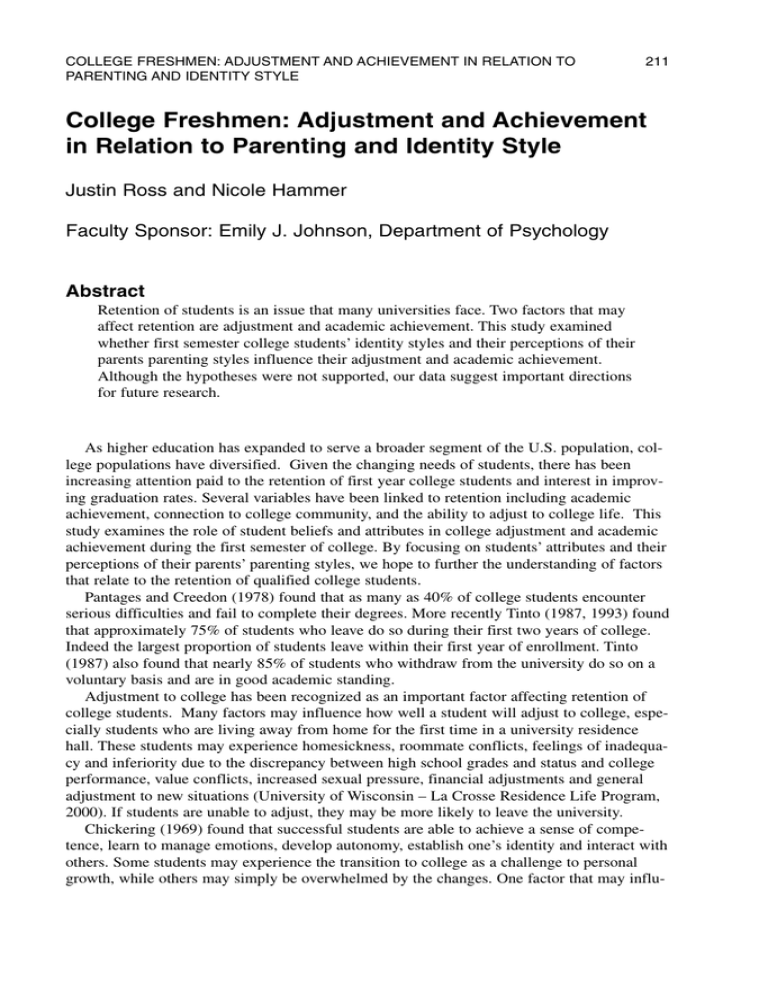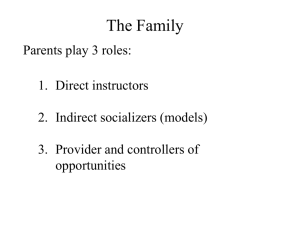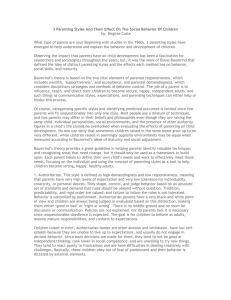College Freshmen: Adjustment and Achievement Justin Ross and Nicole Hammer
advertisement

COLLEGE FRESHMEN: ADJUSTMENT AND ACHIEVEMENT IN RELATION TO PARENTING AND IDENTITY STYLE 211 College Freshmen: Adjustment and Achievement in Relation to Parenting and Identity Style Justin Ross and Nicole Hammer Faculty Sponsor: Emily J. Johnson, Department of Psychology Abstract Retention of students is an issue that many universities face. Two factors that may affect retention are adjustment and academic achievement. This study examined whether first semester college students’ identity styles and their perceptions of their parents parenting styles influence their adjustment and academic achievement. Although the hypotheses were not supported, our data suggest important directions for future research. As higher education has expanded to serve a broader segment of the U.S. population, college populations have diversified. Given the changing needs of students, there has been increasing attention paid to the retention of first year college students and interest in improving graduation rates. Several variables have been linked to retention including academic achievement, connection to college community, and the ability to adjust to college life. This study examines the role of student beliefs and attributes in college adjustment and academic achievement during the first semester of college. By focusing on students’ attributes and their perceptions of their parents’ parenting styles, we hope to further the understanding of factors that relate to the retention of qualified college students. Pantages and Creedon (1978) found that as many as 40% of college students encounter serious difficulties and fail to complete their degrees. More recently Tinto (1987, 1993) found that approximately 75% of students who leave do so during their first two years of college. Indeed the largest proportion of students leave within their first year of enrollment. Tinto (1987) also found that nearly 85% of students who withdraw from the university do so on a voluntary basis and are in good academic standing. Adjustment to college has been recognized as an important factor affecting retention of college students. Many factors may influence how well a student will adjust to college, especially students who are living away from home for the first time in a university residence hall. These students may experience homesickness, roommate conflicts, feelings of inadequacy and inferiority due to the discrepancy between high school grades and status and college performance, value conflicts, increased sexual pressure, financial adjustments and general adjustment to new situations (University of Wisconsin – La Crosse Residence Life Program, 2000). If students are unable to adjust, they may be more likely to leave the university. Chickering (1969) found that successful students are able to achieve a sense of competence, learn to manage emotions, develop autonomy, establish one’s identity and interact with others. Some students may experience the transition to college as a challenge to personal growth, while others may simply be overwhelmed by the changes. One factor that may influ- 212 ROSS AND HAMMER ence whether this transition is overwhelming or a manageable challenge is a student’s identity style. Berzonsky (1989) has identified three major identity styles: normative, informative, and diffuse/avoidant. Those who use the normative identity style tend to conform to society as well as familial expectations. They have a high degree of commitment to authority. Research indicates that they are also conscientious and agreeable, but they have a low tolerance for ambiguity and a strong need for structure and cognitive closure (Berzonsky & Kinney, 1995). People using the informative identity style actively seek out information and solutions before committing to one specific idea or solution. In general they are more open, well rounded and have more effective coping skills. Research has shown that utilization of an informative identity style is positively associated with self-reflection, problem-focused coping efforts, high need for cognitive complexity, and vigilant decision making. They also show the conscientiousness, agreeableness, and openness factors of the big five personality dimensions (Berzonsky, 1990). Those who use the diffuse/avoidant identity style tend to procrastinate and only look at things in a situation-by-situation basis when making decisions. Deployment of a diffuse/avoidant identity style has been positively associated with avoidant coping, selfhandicapping behavior, other-directedness, and maladaptive decisional strategies (Berzonsky, 1994). It has been negatively correlated with self-reflection, conscientiousness, and cognitive persistence (Berzonsky, 1994). Research suggests that when linked to college adjustment/achievement, those who have an informative identity style are more likely to succeed in their first semester of college. Another factor that may be involved in students’ adjustment to and achievement in college is the perception of their parents’ parenting style. Baumrind (1971) identified three major categories of parenting styles. Authoritative parents are both demanding and responsive, characterized as being warm and moderately strict. While they tend to give their children direction, they are also open and willing to hear their children’s opinions. These parents often set limitations for their children, yet encourage them to become autonomous. Research by Baumrind (1971, 1991) suggests that the authoritative parenting style is correlated with more positive outcomes in children, both academically and socially. Alternatively, authoritarian parents are demanding but unresponsive. Parents who use an authoritarian style place such a high value on conformity that they are unresponsive when children are unwilling to obey. Baumrind (1967, 1971) found that children of authoritarian parents tend to be anxious, withdrawn, and unhappy. It has also been found that students who have authoritarian parents continue to be less well adjusted than those students who have authoritative parents (Steinberg, Lamborn, Dornbusch, & Darling, 1994). Permissive parents do not place high demands on their children but are highly responsive. Parents utilizing this style have a lax approach to disciplining their children. They allow their children to make many of their own decisions at an age when they are not yet capable of doing so. Baumrind (1971, 1991) found that permissively reared children are less involved in school learning and are more disobedient and rebellious than children reared with authoritarian and authoritative parenting styles. We hypothesize that college freshmen who perceive their parents’ parenting style to be authoritative will also be more likely to use an informative identity style. In addition, we hypothesize that student’s perception of an authoritative parenting style and an informative identity style will each be positively related to adjustment and achievement in the first semester of college. COLLEGE FRESHMEN: ADJUSTMENT AND ACHIEVEMENT IN RELATION TO PARENTING AND IDENTITY STYLE 213 METHOD Participants College freshmen in their first semester at the University of Wisconsin - La Crosse were surveyed. Students living on campus in Reuter, Laux and Coate Halls (primarily freshmen residence halls) were given surveys at two points in time. Of the 400 students who completed the first survey distributed in September, 106 (27%) completed the second survey in March. Of the 106 completing both sets of surveys, 23 were males (22%), 83 were females (78%) and 98.9% were European Caucasian. The remaining 1.1% were distributed among African American, Asian American, and Native American. Procedure Students were given a packet containing three questionnaires designed to measure perception of parents parenting style, identity style, and their anticipated adjustment to college within their first two weeks of arriving on campus in September 2001. They also received a demographic questionnaire. The packet of questionnaires were given out to each student at their first floor meeting and collected by their resident assistant. In March 2002, students were given an additional questionnaire at a floor meeting containing one measure designed to look at actual adjustment in the first semester of college, and were asked to self-report their first semester GPA. Measures The Parental Authority Questionnaire (PAQ) is a 30-item five point Likert-type inventory that measures perceptions of parenting styles based on Baumrind’s theory. The questionnaire yields separate scores for mothers and fathers (Buri, 1991). The Identity Style Inventory (ISI) is a 40-item five point Likert-type measure that examines the different identity styles as classified by Berzonsky (1989). The Anticipated Student Adjustment to College Questionnaire (ASACQ ) is 67-item seven point Likert-type questionnaire that looks at students’ predictions as to how they anticipate they will feel about different aspects of the university experience. The Student Adjustment to College Questionnaire (SACQ) is the second form of this measure that measures actual adjustment to the university. It also contains 67 items and utilizes a 7 point Likert type scale (Baker, 1980). The PAQ, ISI, and ASACQ along with the demographic questionnaire were included in the initial set of surveys. The SACQ was the only measure given in March. All four measures have been found to be both valid and reliable in past research (Baker, 1980, Buri, 1991, Berzonsky 1989). RESULTS A stepwise linear regression was performed to test the hypotheses that student’s perception of an authoritative parenting style and an informative identity style will each be positively related to adjustment and achievement in the first semester of college. The dependent variables were GPA and SACQ scores. Gender, identity styles, perceptions of parenting styles and perception of adjustment to college, were entered as predictors. Crosstab’s using a Chi Square Test was used to examine whether the Authoritative Parenting Style predicted the Informative Identity Style. None of the hypotheses were supported. Only the normative identity style predicted SACQ scores after controlling for ASACQ and gender (F (1, 106)= 8.193, p = .005). GPA was predicted only by a perception of the father as being permissive (F (1,97) = 8.019, p = .006). 214 ROSS AND HAMMER Table 1 Gender Frequencies of Perception of Parenting and Identity Stylea _________________________________________________________________________ Male Female n % n % ________________________________________________________________________ Perception of Fathers Authoritative 15 65 51 64 Permissive 2 3 ** Authoritarian 8 35 27 33 Perception of Mothers Authoritative 16 70 62 81 Permissive 1 4 1 1 Authoritarian 6 26 14 18 Identity Style Informative 21 81 59 79 Normative 6 8 Diffuse Avoidant 4 15 6 8 Commitment 1 4 4 5 _________________________________________________________________________ a Reported for participants with complete pre and post measures (**) p = .01 Table 2 Mean and Standard Deviation for Gender, ASACQ, and GPA _________________________________________________________________________ _ Male Female _________________________________________________________________________ ASACQ Scorea Mean 341.77 336.14 N 43 145 SD 32.85 38.1 SACQ Scoreb Mean 335.96 338.55 N 28 83 SD 30.73 43.36 GPA b Mean 2.77 3.13 81 21 N SD 0.6 0.55 ___________________________________________________________________________ a Reported by all participants with complete data (missing data made some surveys unusable) b Reported by those completing the 2nd measure ASACQ – Anticipated Student Adaptation to College Questionnaire SACQ – Student Adaptation to College Questionnaire COLLEGE FRESHMEN: ADJUSTMENT AND ACHIEVEMENT IN RELATION TO PARENTING AND IDENTITY STYLE 215 Table 1 provides frequency of perceived parenting style and identity style based on gender. As is readily apparent, an unequal distribution of parenting and identity styles were represented. The majority of both male and female participants perceived their parents as authoritative (an average of 64% for fathers and 78% for mothers). Only four participants perceived parents as permissive. Both males and females overwhelmingly rated themselves as using the informative identity style (79%) while only 6 females (8% of females) rated themselves within the normative style. Table 2 provides the means and standard deviation for the ASACQ, SACQ, and GPA. DISCUSSION This study examined the hypotheses that (1) college freshmen perception of an authoritative parenting style and an informative identity style will each be positively related to adjustment and achievement in the first semester of college and (2) students who perceive their parents’ parenting style to be authoritative will also be more likely to use an informative identity style. Our hypotheses were not confirmed. Authoritative parenting was not related to an informative identity style. Authoritative parenting was also not related to college adjustment and achievement. However, participants who perceived fathers as permissive received lower GPA’s. Furthermore, the Normative Identity Style, not the Informative Identity Style, was a predictor of college adjustment. However, these findings must be viewed with extreme caution in that only four students perceived fathers as permissive and only six fell into the Normative Identity style. In fact, disproportionate distribution of several variables may partially explain our unexpected results. Parenting styles were disproportionately distributed. Of the participants who completed both surveys, approximately 70% perceived parents as authoritative, 28% perceived parents as authoritarian, and only 8% of the participants perceived parents as permissive. As indicated above, perception of fathers as permissive was the only factor that related significantly to GPA. Student’s who reported permissive fathers were more likely to receive a lower first semester GPA. Parents who use a permissive parenting style tend to have lower expectations of their children and tend to provide a less structured environment. Lack of structure in the home environment may adversely affect a student’s ability to develop time management skills and to create an environment that is conducive to academic success. Identity styles were also disproportionately distributed. Almost 80% of participants were categorized as Informative and only 8% (all female) self-categorized as Normative. Nearly 15% self-categorized into the Diffuse Avoidant or Commitment style. The Normative Identity Style is the only predictor of adjustment to college. The Normative Identity Style represents those that follow social norms. These students may show better adjustment because they are following rules, authority, and social norms on campus, all of which may allow for initial adjustment to college life. The disproportionate number of Informative Identity Style participants may have occurred because these individuals may be more likely to attend college. Informative Identity Style students actively seek out solutions and consider “the big picture” when making decisions. These students may be more likely to attend college because they see college as the best opportunity for growth and for opening doors to their future. The low numbers of individuals categorized as diffuse avoidant could be expected on a college campus. Making decisions on a situation-by-situation basis may preclude these individuals from doing the advanced planning necessary to make it into college in the first place. However, it is difficult to explain the low number of individuals categorized within the commitment iden- 216 ROSS AND HAMMER tity style since many students come to college with a clear sense of a major, even though students also are likely to change their major at least once. Perhaps other areas of their lives are too uncertain for students to self-categorize into this group. Additionally, there was a significant gender imbalance in this study. Approximately two thirds more females completed both sets of surveys than did males. Although university populations slightly favor females, whether college females are more likely to participate in research and complete questionnaires, and why this might be so, warrants further investigation. IMPLICATIONS This study suggests several areas for future research. Previous research indicates that an individual’s identity status changes over the course of adolescence and into young adulthood, particularly for those who attend college. The same may be true of identity styles. Longitudinal studies could help determine whether individuals maintain a particular identity style throughout high school and college and whether different styles predict the likelihood of college attendance. Furthermore, research on developmental change in identity during the college years and its possible relation to student engagement, satisfaction, long-term retention and academic success, and ultimate career choices may prove fruitful. University officials may also want to use the ASACQ as a predictor of retention. For example, perhaps student’s with very high ASACQ scores or low ASACQ scores may be more likely to leave school as the reality of their college experience does not match that of their expectations of college. Finally, future research will benefit from using a larger, more diverse, and more gender-balanced population. LIMITATIONS Of the 400 original participants only 106 completed both surveys. This small percentage (27%) may have reduced the predictive power of our variables. Another possible factor that may have reduced power and validity in this study are the events of September 2001. Participants received the initial survey September 11th. The effects of these events may have impacted not only students’ willingness to complete the surveys, but may have also influenced how they responded to items on the various measures. These possible effects, of course, will never be known. REFERENCES Baker, R.W. (1980). Anticipated student adaptation to college questionnaire. Unpublished manuscript Baumrind, D. (1971). Current patterns of parental authority. Developmental Psychology Mongraphs, 4 (2). Baumrind, D. (1991). The influence of parenting style on adolescent competence and substance use. Journal of Early Adolescence, 11, 56-95. Berzonsky, M.D. (1989). Identity style: Conceptualization and measurement. Journal of Adolescent Research, 4, 268-282. Berzonsky, M.D. (1990). Self-construction over the life-span: A process perspective on identity formation. In G.J. Neimeycr & R.A. Neimeyer (Eds.), Advances in personal construct-psychology (Vol 1, pp 155-186). Greenwich, CT: JAI. COLLEGE FRESHMEN: ADJUSTMENT AND ACHIEVEMENT IN RELATION TO PARENTING AND IDENTITY STYLE 217 Berzonsky, M.D. & Kinney, A. (1995). Identity style and need for cognitive closure. Paper presented at the Society for Research on Identity Formation, Dog Island, FL. Berzonsky, M.D. (2000). Identity status, identity processing style, and the transition to university. Journal of Adolescent Research, 15, 81-99. Buri, J.R. (1991). Parental authority questionnaire. Journal of Personality Assessment, 57, 110-119. Chickering, A. (1969). Education and Identity. San Francisco: Jossey-Bass Hickman, G.P., Bartholomae, S. & McKenry, P.C. (2000). Influence of parenting styles on the adjustment and academic achievement of traditional college freshman. Journal of College Student Development, 41 (1), 41-53. Pantages, T.J. & Creedon, C.F. (1978). Studies of college attrition: 1950-1975. Review of Educational Research, 48, 49-101. Scwartz, S.J, Mullis, R.L., Dunham, R.M. & Waterman, A.S. (2000). Ego identity status, identity style, and personal expressiveness: An empirical investigation of three convergent constructs. Journal of Adolescent Research, 15, 504-522. Steinberg, L.D., Lamborn, S.D., Dornbusch, S.M., & Darling, N. (1994). Impact of parenting practices on adolescent achievement: Authoritative, parenting, school involvement, and encouragement to succeed. Child Development, 63, 1266-1281. Tinto, V. (1993). Leaving college: Rethinking the causes and cures of student attrition. Chicago: University of Chicago Press. University of Wisconsin – La Crosse. (2000). Residence Life Program. [Brochure]. La Crosse, WI: Author 218




